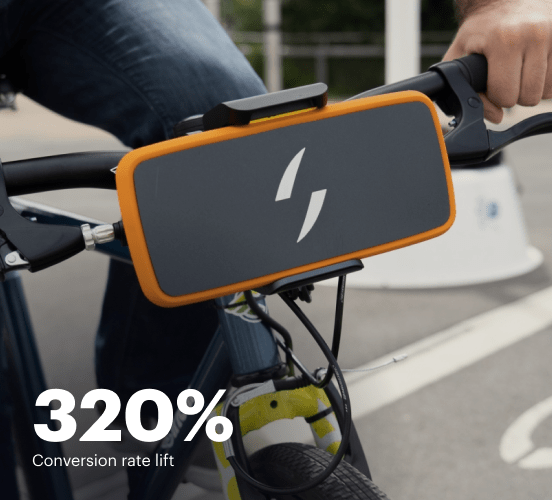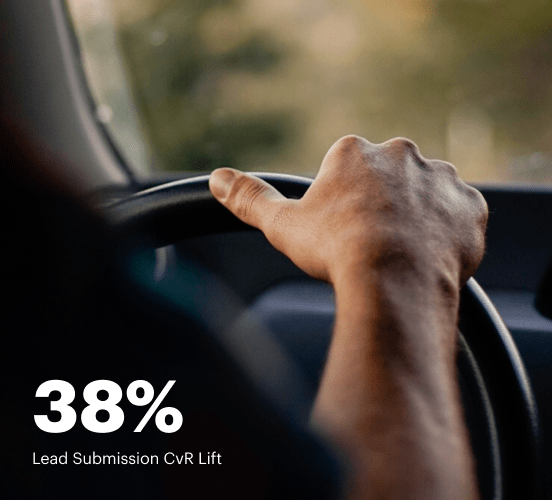Paperform vs. Gravity Forms: the best platform for a seamless web experience
Discover how Paperform compares to Gravity Forms regarding features and usability. Find out which platform provides the competitive advantage your business deserves.
Get startedSee how Instapage stacks up against the competition
| Feature | Instapage | Other builders |
| Drag-and-Drop Tools | ||
| Conversion-optimized templates | ||
| Manual and AI-powered A/B Tests | ||
| AI content suggestions | ||
| Popups and sticky bars | ||
| Canvas and grid blocks | ||
| Reusable and global elements | ||
| Form and popup builders | ||
| Built-in Heatmaps | ||
| Central analytics dashboard | ||
| Ad-to-page personalization and collections | ||
| Contacts, lists, and email | ||
| Dedicated, full-service CRO experts | ||
| Enterprise-ready platform |
Leading the way in building high-performing landing pages





Why Instapage is the smarter choice for your campaigns
Get everything you need to build, scale, and optimize high-converting landing pages—without coding.

Easier page building without coding
Instapage offers a flexible and seamless page creation experience with a library of 500+ conversion-focused layouts, Instablocks®, a drag-and-drop builder, and AI content generation. With technologies like Thor Render Engine®, you can create on-brand, mobile-responsive landing pages that load quickly and start converting during initial visitor clicks.

More insights — better results
Instapage lets you see in detail how each landing page experience and variation is performing so you can make targeted changes that boost page conversions. Use heatmaps for a better understanding of on-page activities, run A/B tests and AI-assisted experiments, and then track and evaluate results within robust analytics dashboards.

More personalized experiences
Instapage lets you quickly create high-performing landing pages tailored to each of your ad campaigns. Deliver personalized experiences for distinct audiences using dynamic text replacement. Effortlessly align specific advertisements to unique pages with AdMaps. Monitor audience-level metrics using our advanced data tools.

Built-in collaboration
Instapage collaboration capabilities bring your entire team together to speed up the process of landing page review, approval, and launch. No more frustrating and unnecessary revisions or edits scattered across emails. Provide instant feedback, conduct real-time page edits, and securely share your pages with outside stakeholders.

Free up time for your business
Invest time into business growth, not busy work. Launch landing pages faster with reusable forms and templates. Build once, reuse forever.
Explore all integrations






Easier page building without coding
Instapage offers a flexible and seamless page creation experience with a library of 500+ conversion-focused layouts, Instablocks®, a drag-and-drop builder, and AI content generation. With technologies like Thor Render Engine®, you can create on-brand, mobile-responsive landing pages that load quickly and start converting during initial visitor clicks.
More insights — better results
Instapage lets you see in detail how each landing page experience and variation is performing so you can make targeted changes that boost page conversions. Use heatmaps for a better understanding of on-page activities, run A/B tests and AI-assisted experiments, and then track and evaluate results within robust analytics dashboards.
More personalized experiences
Instapage lets you quickly create high-performing landing pages tailored to each of your ad campaigns. Deliver personalized experiences for distinct audiences using dynamic text replacement. Effortlessly align specific advertisements to unique pages with AdMaps. Monitor audience-level metrics using our advanced data tools.
Built-in collaboration
Instapage collaboration capabilities bring your entire team together to speed up the process of landing page review, approval, and launch. No more frustrating and unnecessary revisions or edits scattered across emails. Provide instant feedback, conduct real-time page edits, and securely share your pages with outside stakeholders.
Free up time for your business
Invest time into business growth, not busy work. Launch landing pages faster with reusable forms and templates. Build once, reuse forever.
Explore all integrationsGet started with Instapage in a few steps
-
Create your Instapage account
Start with Instapage by signing up via Google or your email. You'll get access to a free 14-day trial to discover Instapage capabilities. Feel free to cancel anytime during the 14-day trial if you decide that our product is not suitable for your business. -
Build and personalize your page
Create your first landing page from scratch or choose a template from 500+ customizable layouts. Use the drag-and-drop builder to add page elements, fonts, and backgrounds, refine content with AI, or add custom HTML, Javascript, and CSS. -
Review and make edits
Collaborate on page designs and streamline review processes. Invite your team members and stakeholders to review, edit, and provide feedback on your landing page. Collaborate knowing your page is confidential and only accessible to authorized users. -
Publish and track page performance
Publish your page to a domain or custom URL. Connect your pages to the ads you've created and track page performance within the analytics dashboard, run A/B tests and AI experiments, analyze results, and continuously optimize your landing page to maintain high conversions.
Paperform vs. Gravity Forms: The Ultimate Face-Off
Entering the realm of landing page builders can feel like stepping into a heavyweight boxing ring, with giants like Paperform and Gravity Forms ready to duke it out. Each platform offers a unique suite of functionalities, catering to various aspects of the digital marketing landscape. As businesses strive to harness the full potential of their online presence, they find themselves choosing between these two titans. However, the landscape is evolving, and lurking in the shadows is another contender, Instapage, prepared to change the game. In this article, we'll dissect the strengths, weaknesses, and unique features of Paperform and Gravity Forms, while keeping a close eye on what Instapage has to offer. When it comes to online forms, surveys, and landing pages, the right tool can make all the difference in conversion rates and customer engagement.
Introducing the Contenders
Paperform and Gravity Forms are both celebrated tools in the digital marketing domain, each bringing something unique to the table. Paperform is known for its sleek, user-friendly interface and versatility, allowing users to create customized forms and pages with ease. It’s particularly appealing to those who value aesthetics without sacrificing functionality. On the other hand, Gravity Forms prides itself on its powerful customization options and integrations. A go-to for users on WordPress, it provides extensive flexibility for form creation and management. Each platform has carved out a niche, making them formidable opponents in the digital marketplace. As we dive deeper into specifics, you'll see their contrasting approaches and how they cater to different target audiences. But don’t forget, Instapage is also casting a shadow that could easily shift the odds.
Feature Face-Off: Who Packs the Bigger Punch?
When it comes to features, both Paperform and Gravity Forms stand tall, each showcasing their strengths in different ways. Paperform offers a visually appealing editor that allows users to build forms by simply typing like you're drafting a document. You can add images, videos, and even payment options, customizing the experience for every user. Conversely, Gravity Forms incorporates robust integrations with popular apps and plugins, enabling sophisticated automation and workflow management. It's perfect for those who need high-level customization for complex projects. Yet, rumors swirl of a hidden gem—Instapage—with a suite of features that some may find hard to resist. It seems that the fight isn't just about who has more features, but who uses them best.
Ease of Use: The User-Friendly Showdown
Every user—whether fresh to digital marketing or an experienced pro—desires a platform that makes their life easier. Understanding the learning curve is like navigating a maze. Paperform's interface is as elegant as it is intuitive, allowing users to hit the ground running without feeling overwhelmed. Consider it a straightforward walk through a park. In contrast, Gravity Forms might be more of an adventure, with a variety of options that require a bit of patience to master. Both serve their respective audiences well, but each journey has its distinct flavor. The real question is, which path aligns better with your needs? As we continue to explore, remember that not every stairway leads to success; sometimes, the most enchanting ride is a simple one.
The Impressive Toolkit of Paperform:
- Stunning templates for creative form design
- Easy integration with payment gateways like Stripe and PayPal
- Customizable forms with conditional logic
- User-friendly drag-and-drop interface for beginners
- Seamless data collection and management
The Power Features of Gravity Forms:
- Advanced conditional logic and field customizations
- Wide range of third-party integrations
- Multi-page forms for extensive data collection
- Robust reporting and analytics tools
Common Strengths Shared by Both Platforms:
- Automatic email notifications upon form submission
- Mobile responsiveness for users on the go
- Easy embedding options on any website
- Data export capabilities for further analysis
- Strong security measures to protect user data
As we tally the features, it’s amusing to note how both platforms exhibit strengths befitting a champion. However, Instapage is quietly enhancing its offers, proving to be a much more versatile matchup for users who seek a complete blend of aesthetic appeal and comprehensive functionality. It’s interesting how often contenders emerge when least expected!
Speed and Performance: A Vital Round
In the battle for audience retention, speed is a crucial factor. A website that loads slower than molasses on a chilly day can turn away potential customers faster than you can say ‘bounce rate.’ Both Paperform and Gravity Forms boast fast-loading features, ensuring that your pages are engaging and efficient. However, ensuring mobile responsiveness is just as important, as an increasing number of users engage with forms from their devices. Gravity Forms integrates seamlessly with WordPress, allowing for quick loading times. Meanwhile, Paperform focuses on optimal loading speed across all platforms. Don't underestimate performance in this arena; it can make or break your user experience.
Customer Support: The Unsung Hero
In the world of customer service, having the right support can be the difference between a lovely experience and a downright frustrating one. Both Paperform and Gravity Forms offer extensive support, with dedicated channels for customer queries. Paperform provides email support and boasts a variety of tutorials and resources for self-help. Gravity Forms, on the other hand, has a robust community forum and extensive documentation to guide users. Picture customer support as the trusty sidekick, ever-ready to leap into action when the user needs assistance. The combination of resources and quick responses plays a significant role in user satisfaction.
Pricing Structures: Picking the Best Bargain
Advantages of the Paperform Pricing Model:
- Flexible pricing tiers based on features and usage
- No hidden costs for users to worry about
- Free trial option that showcases features
- Cost-effective solution for small to medium-sized businesses
The Strengths of Gravity Forms Pricing Strategy:
- One-time payment option for lifetime license
- Markdown and payment integration at lower levels
- Offers add-ons for specialized needs
- Pricing tailored for larger organizations and enterprises
When considering pricing, both Paperform and Gravity Forms present compelling offers tailored to various budgets. But enter Instapage, which often outshines both competitors with its flexible pricing strategy designed for maximum value. Each of these platforms holds an advantage, but as business needs evolve, the need for adaptable pricing will remain paramount.
In examining the transparent pricing plans, it becomes clear that flexibility can heavily influence the decision-making process. But don't forget that the odd surprise might sneak in when least expected, often from underlying fees that weren't initially apparent.
Meet Instapage: The Game-Changer
Kicking down the door to dominance is Instapage, a platform that redefines expectations in the world of landing pages and marketing funnels. Known for its optimization capabilities, it holds the potential to elevate conversions through targeted features that streamline user experience. Instapage provides an array of templates along with A/B testing options, a rarity among its peers. Moreover, its integration possibilities align seamlessly with various marketing strategies. Don’t shadow Instapage out; it combines the strengths of both Paperform and Gravity Forms while overcoming their weaknesses. As you explore your options, remember that the right tool could be the turning point for your business, and it may just lie in the unique offering of Instapage.
In conclusion, as we reflect on the variety of choices, it’s crucial to choose a platform that aligns best with your goals. Whether it’s Paperform, Gravity Forms, or Instapage leading your charge, it can be the catalyst for your success. Each solution has its perks, and navigating these waters wisely ensures you find exactly what you need. Continue to build your marketing journey; the choice is yours, and your peak awaits!










